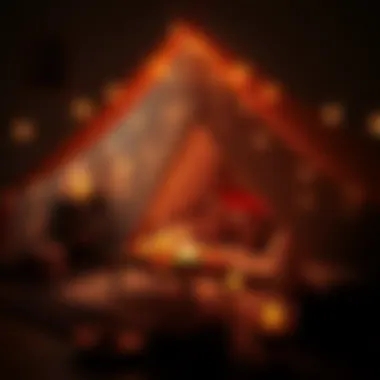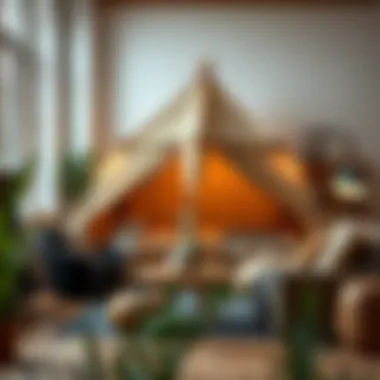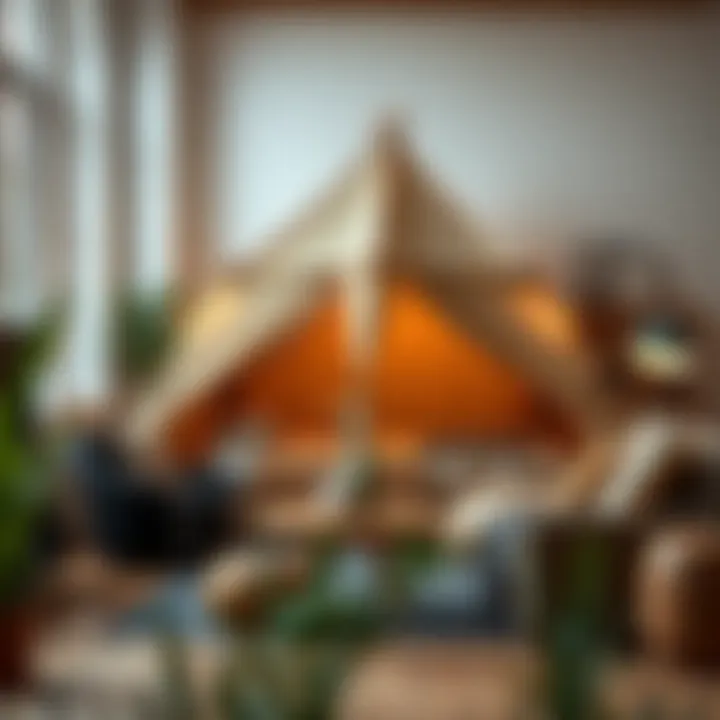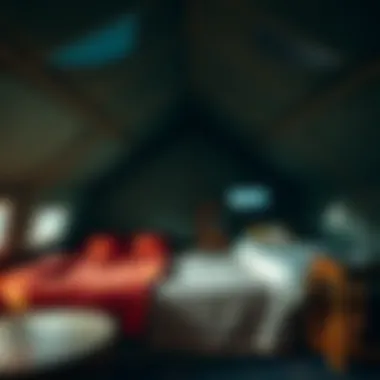Indoor Camping Tents: Design, Uses, and Benefits


Intro
Indoor camping tents have begun to carve out a unique and fascinating niche within the realm of home decor and leisure activities. Far beyond their traditional role as outdoor shelters, these tents have morphed into multifunctional spaces that reflect creativity and comfort. This guide navigates the vibrant landscape of indoor camping tents, touching on their diverse designs, functional uses, and even cultural significance.
In an age where the concept of home is evolving, indoor camping tents resonate with the desire for cozy spaces away from the hustle and bustle of everyday life. The allure lies not just in the tent itself, but in how it can transform a room into a retreat—whether for a fun family night or a stylish corner in an open-concept living area.
As we delve deeper into this exploration, we will touch on the latest trends in tent design, how to select the perfect tent for your living space, and essential practical tips that will help you set up and maintain your indoor camping setup. The world of indoor camping tents isn’t just about aesthetics; it's about creating environments that foster relaxation, creativity, and a touch of adventure.
Furniture Design Trends
Changes in design trends can often influence how these unique tents are incorporated into a home setting. The evolution of materials and textures used in furniture is also mirrored in the indoor camping tent industry. Today, let’s take a closer look at both trending materials and the vibrant color palettes that are currently in vogue.
Trending Materials and Textures
When it comes to indoor camping tents, we see a delightful mix of traditional and innovative materials. Canvas is a beloved classic, evoking memories of the great outdoors while lending a rustic warmth to interior spaces. However, more modern options are emerging, involving lightweight, water-resistant fabrics that not only make setup easier but also enhance the overall durability of the tents. Consider using materials like ripstop nylon or polyester, which are easy to clean and maintain.
Additionally, textures play a critical role. The roughness of canvas can be juxtaposed with soft furnishings like blankets and cushions, adding layers of comfort. Pairing your tent with elements like reclaimed wood or natural fibers can heighten that cozy appeal.
Color Palettes and Styles
The color schemes that are trending in indoor camping tents are equally important. The earthy tones of beige, ochre, and olive green are making headway, infusing a sense of calm and grounding into indoor spaces. These colors not only complement the natural materials but can also vary in shade and saturation to create depth and dimension.
If you fancy a more playful look, brighter hues like vibrant yellows or deep blues can structure a delightful contrast while channeling a sense of adventure. Patterns can also breathe life into a tent. Floral motifs or geometric designs can invigorate the tent’s aesthetic, rendering it not just a functional item, but also a piece of art that enhances your living space.
"An indoor camping tent isn’t merely a space; it’s a canvas where memories can be painted and stories can unfold."
Moreover, the style of the tent should resonate with the overall decor of your home. Think about going with a vintage look to complement your rustic furniture or a more contemporary tent that follows sleek lines to align with modern decor.
As we adapt these elements of design into our homes, we find the richness that indoor camping tents bring to leisure and daily life. The next section will provide practical tips for furniture selection to ensure a harmonious integration of your indoor camping tent into your living area.
Prologue to Indoor Camping Tents
Indoor camping tents have captured the imagination of many homeowners and designers alike. They serve not just as a nod to the great outdoors, but also as versatile spaces within the comfort of one’s home. These tents offer an appealing mix of creativity and practicality, elevating them from mere playthings to substantial elements in modern living spaces.
Over the last few years, indoor camping has burgeoned into a unique trend, encouraging individuals to embrace adventure without straying too far from home. With families increasingly looking for ways to engage in quality time together, these tents function as a delightful sanctuary. They provide children with a space for imaginative play, while adults can utilize them for relaxing getaways within the confines of their homes.
Understanding the Appeal
The allure of indoor camping tents stems from their ability to transform any area of a home into something special. Whether it's a cozy reading nook or a fun space for family bonding, these tents can easily cater to various needs. They add a dash of whimsy to living areas that often feel mundane, allowing users to reimagine their domestic environments.
From the colorful patterns that catch the eye to the simple layout that facilitates easy assembly, these tents come in various styles and sizes, accommodating different tastes and preferences. This versatility is key to their rising popularity.
Indoor camping tents can turn an ordinary room into an extraordinary playground or relaxation area, offering an escape without leaving the house.
While many regard these tents as playtime essentials for kids, their potential stretches far beyond childhood. Adults, too, can benefit from creating their own cozy retreats, fostering a sense of tranquility or creativity. As society continues to prioritize work-life balance, having a personal space for unwinding becomes increasingly essential.
In summary, understanding the importance of indoor camping tents provides a foundation for exploring their design features, functionality, and cultural significance. As we dive deeper into what makes these tents such a captivating addition to any home, we will break down their various aspects to give a well-rounded perspective on their multifaceted nature.
Design Features of Indoor Camping Tents
The design features of indoor camping tents play a pivotal role in how these structures function within our homes. A thoughtful selection of design elements can significantly enhance user experience. From choice of materials to the overall aesthetic, each feature serves a distinct purpose while contributing to the tent's appeal and utility.
Materials Used in Construction
Understanding the materials used in indoor camping tents is crucial for making an informed choice. The typical options include nylon, polyester, cotton, and various blends. Each material has its own set of advantages:
- Nylon is lightweight, making it easy to set up and transport. However, it may not provide the same level of warmth as other options.
- Polyester offers excellent UV protection, which can be valuable for users who wish to place their tent near windows or in sunlit areas.
- Cotton, while heavier, provides great insulation and breathability, creating a comfortable environment even in warmer climates.
Additionally, some tents have weather-resistant coatings to enhance durability and protect against spills or splashes. Selecting the right material directly impacts the tent's lifespan and how well it complements its surroundings.
Tent Styles and Configurations
When it comes to styles and configurations, indoor camping tents come in various shapes and setups that cater to different needs. A few popular styles include:
- Dome Tents: These have a simple, curved design and are quick to erect, making them the go-to for spontaneous camping.
- Geodesic Tents: Known for their strength, these tents can withstand windy conditions, adding a layer of reliability.
- Cabin Tents: These provide ample height and space, making them ideal for group activities like family game nights or storytelling sessions.
Each configuration not only affects the tent's functionality but also how well it fits into a given room. A smaller dome tent might suit a cozy nook, while a larger cabin tent could become the centerpiece of a spacious living area, inviting curiosity and interaction.
Color and Aesthetic Considerations
Color and aesthetics are among the most engaging aspects of indoor camping tents. Bright, vibrant colors can infuse energy into a room, while muted tones may lend a feeling of serenity. Here are a few considerations when choosing the right color:


- Room Theme: Match the tent’s color palette with existing decor to create harmony. A navy tent can complement nautical themes, while pastel colors suit a child’s play area.
- Psychological Impact: Colors influence mood. Warm colors like red and orange stimulate activity, whereas blues and greens can create a calming environment.
Beyond color, unique patterns can also add charm. This might include whimsical prints for children's tents or sophisticated designs for adult spaces. As such, an indoor camping tent can function as more than just a sleeping space; it acts as a style statement that reflects the homeowner's personality.
Ultimately, the design features of indoor camping tents should resonate with your lifestyle and aesthetic preferences. Undertaking a careful assessment of materials, styles, and colors ensures your tent serves as a delightful extension of your home.
Functional Aspects
Indoor camping tents are more than just whimsical alternatives to traditional sleeping arrangements; they serve a myriad of practical purposes that transform the way families interact within their homes. Understanding the functional aspects of these tents can illuminate their significance in enhancing living spaces, encouraging family bonding, and promoting creativity among children.
Space Utilization in Homes
One of the primary benefits of indoor camping tents is their ability to optimize space in a home. Most homes, especially in urban areas, can be cramped. An indoor camping tent offers a perfect solution that utilizes otherwise underused areas.
- Efficient Use of Small Spaces: Tents can easily fit in corners, living rooms, or even bedrooms. They provide a playful nook without the need for permanent structures or bulky furniture.
- Transforming Unused Areas: An empty space can come alive with a tent, inviting activities that might otherwise take place outdoors. This ability to create a designated area for relaxation, play, or even work can make a world of difference in a tight living arrangement.
- Flexible and Mobile: Indoor tents are often lightweight and can be moved around as needed. This mobility allows homeowners to adapt their layouts based on changing needs or occasions. Whether it's a spontaneous movie night or a cozy reading corner, an indoor tent can easily accommodate these needs.
Indoor Camping for Family Activities
Families often seek unique ways to engage with each other in a world dominated by technology. Indoor camping tents can facilitate this engagement by creating an environment that encourages interaction and fun.
- Quality Family Time: Setting up a tent can be an activity in itself. Assembling it together fosters teamwork and communication among family members. Inside, families can gather for games, storytelling, or simply sharing meals, transforming mundane routines into memorable experiences.
- Safe Environment for Play: Indoor camping provides a controlled atmosphere where children can explore and engage in imaginative play under supervision. Unlike outdoor camping, the comfort of home mitigates risks like adverse weather or wild animals.
- Event Hosting: Tent setups can effectively host mini-events such as birthday parties or sleepovers, creating a festive atmosphere without cluttering the home or requiring complex arrangements.
Promoting Creativity Among Children
The whimsical nature of indoor camping tents can ignite imagination in children, providing them with a canvas to explore their creativity freely.
- Encouraging Role Play: Tents serve as perfect backdrops for story-driven play. Children can pretend they are explorers in a jungle or astronauts in a spaceship, enhancing their role-playing experiences and social skills.
- Art and Craft Space: An indoor tent can double as an arts and crafts area, protecting surfaces while allowing children to express their creativity. The enclosed space can help kids concentrate on their projects while providing an area they can call their own.
- Themed Learning Experiences: With a little imagination, a simple tent can transform into an educational environment. Parents can host themed learning nights, bringing subjects like science or history alive through themed activities and storytelling inside the tent.
"Creating a special place within a home for camping can nurture connection, creativity, and communication. As simple as it sounds, it's about crafting experiences and memories."
Choosing the Right Indoor Camping Tent
Selecting an indoor camping tent is not just a casual decision; it’s paramount for ensuring comfort and utility within your home. Several elements demand attention when it comes to making the right choice. Your tent should not only fit in your available space but also cater to your intended use, whether it's for a sleepover, a cozy reading nook, or a vibrant play area for children. Being methodical about these considerations can make all the difference in elevating your indoor camping experience.
Assessing Space Requirements
Before making a purchase, take stock of your available space. Do a thorough measurement of the area where you plan to set up the tent. Consider the dimensions; will it just fit in a corner, or do you desire a more spacious setting? Think also about the height - if you want to sit up comfortably inside, don’t overlook this aspect.
- Room Size: Is the tent going in a kid's bedroom or a living space? Each has different size limitations.
- Accessibility: Ensure there is enough room for entry and exit. A cramped space can make the tent feel more like a prison than an adventure.
Furthermore, consider how the tent will fit among existing furniture. A tent in the middle of a tight room can become inconvenient quickly. Hence, assessing space requirements is not merely about size but also about how comfortably it interacts with the surrounding environment.
Durability and Longevity Considerations
When investing in an indoor camping tent, durability should be high on your list of priorities. You need a tent that withstands not just the occasional rough-and-tumble play sessions but also casual everyday wear and tear. Materials play a key role here. Look for tents made of sturdy fabrics, reinforced seams, and reliable zippers. Products from well-regarded brands like Coleman or REI often come with warranties that can serve as a testament to their durability.
- Material Options: Consider polyester or nylon blends that provide resistance against snags and tears.
- Weather Resistance: Even for indoor use, some tents claim water resistance, adding an extra layer of durability.
A well-constructed indoor camping tent not only survives the cycle of seasons but can be repurposed or reused when needed, adding value to your investment over time.
Budgeting for Purchase
When it comes to budgeting for an indoor camping tent, learning where your money will go is crucial. You want to strike that delicate balance between cost and quality. Tents can run the gamut from budget-friendly options to high-end models, so knowing what you need beforehand can prevent buyer’s remorse later on.
- Price Range: Expect to pay anywhere from twenty-five to several hundred dollars, depending on features like size and material. Choosing a more economical tent is viable if the intended use is occasional.
- Hidden Costs: Remember that the initial price is just the start. Accessories like sleeping pads, lights, or even blankets can add up quickly.
Furthermore, consider checking sales or second-hand options for a good deal. Sites like Facebook Marketplace or Craigslist often have lightly used tents that can make for some serious savings.
"Budgeting smartly for your indoor camping tent can lead not only to enjoyment but unforeseen financial savings too."
Setting Up Your Indoor Camping Tent
Setting up your indoor camping tent is more than just a matter of simply pitching a structure within the walls of your home. It transforms a mundane space into an enchanting hideaway, where imagination takes flight and memories are made. The ambiance of an indoor camping experience can enhance family bonding, encourage fun activities, and introduce an alternative approach to downtime. As we delve into the specifics of this assembly, we'll address key elements of planning, safety precautions, and ways to foster a cozy environment.
Planning the Layout
Before you leap into setting up your tent, it's wise to first consider the layout. Finding the ideal spot within your home requires some thought. Is it a corner of the living room, or perhaps in the children’s playroom? The location should be spacious enough to allow movement around the tent while providing a secure feeling for those inside. Opting for a low-traffic area is often beneficial, so the tent doesn't become a nuisance or eyesore when not in use.
Key considerations for planning the layout include:
- Size of the Tent: Ensure that the chosen canvass fits comfortably in the space allocated. A larger tent might need additional support from the surroundings.
- Nearby Amenities: Position the tent close to outlets for lighting, but remember to avoid chaotic chords that may be unsafe.
- Accessibility: Allow for easy entry and exit. This is especially crucial if children are using the tent for play or sleep.
It can help to visualize the final setup using tape on the floor to outline the tent's dimensions, giving you a better sense of how the setup will feel within the space.


Safety Measures and Precautions
Safety is paramount when setting up an indoor camping tent, particularly when kids are involved. Indoor camping isn't without risks; however, with due diligence, you can prevent accidents that may arise.
Safety measures to keep in mind include:
- Flame Hazards: Avoid using candles or any open flame near the tent. Opt for LED lights or battery-operated lanterns to create that camp atmosphere without the risk.
- Sturdiness: Make sure the tent is properly secured and stable. A flimsy setup can lead to little ones getting knocked around or getting stuck.
- Ventilation: Even though you are indoors, ensuring good airflow will help prevent stuffiness and avoid any potential hazards related to sleeping arrangements.
“Safety should be at the forefront of your mind when embracing indoor adventures.”
Taking these precautions will ensure that your indoor camping experience is enjoyable and secure for everyone involved.
Creating a Cozy Atmosphere
Once the planning and safety measures are in place, it's time to focus on aesthetics—the finishing touches that breathe life into the tent. A cozy atmosphere can transform an ordinary setup into a welcoming sanctuary that captivates the imagination.
Here are some ideas to help set the mood:
- Decorative Pillows and Blankets: Throw in some plush pillows and fluffy blankets to make the tent more inviting. This creates an illusion of warmth and comfort.
- String Lights: Adding soft lighting, like string lights or fairy lights, can give the tent a whimsical touch and mimic the stars you would see while camping outdoors.
- Personal Touches: Consider using family photographs or artwork to adorn the tent’s walls. Personal touches can make the tent feel like a special space designed for your household.
- Nature Elements: Bring the outdoors inside by placing some potted plants or small flower arrangements nearby. It helps connect the indoor experience to the joy of camping in nature.
In the upcoming sections, we will explore the maintenance of these tents and how their versatility lends itself to myriad uses in our homes.
Maintaining Indoor Camping Tents
Maintaining indoor camping tents goes beyond just preserving their looks; it's about ensuring durability and maximizing functionality. These structures can serve myriad purposes in a home, from cozy reading nooks to imaginative play spaces for children. A well-maintained tent not only prolongs its lifespan but also enhances the overall indoor camping experience.
Cleaning and Care Instructions
Keeping an indoor camping tent clean requires a bit of routine but is worth the effort. Here are some steps to consider for effective cleaning:
- Initial Inspection: Examining your tent for tears or damage is the first step. Accidental spills or dirt can be common foes during use.
- Light Cleaning: For quick clean-ups after outings, a damp cloth and mild detergent can do wonders. Wipe down surface areas to remove dust or crumbs.
- Deep Cleaning Process: When the tent needs more than a wipe-down:
- Drying: Thorough drying is crucial. Air dry your tent in a ventilated area. Avoid direct sunlight to prevent fading and degrading the fabric.
- Disassemble the Tent: Carefully take it down according to the manufacturer’s instructions.
- Spot Treat Stains: Use specialized fabric cleaning products for tough stains. Always test on a small, hidden area first.
- Soak and Scrub: If warranted, soak the fabric in warm water and gently scrub with a soft-bristled brush. Avoid harsh cleaners as they can degrade the material over time.
To maintain optimal condition, consider using a water-repellent spray post-cleaning. This adds a protective layer against future spills and stains.
Storage Solutions for Off-Season
When the camping season comes to a halt, proper storage of your indoor camping tent takes center stage. Here’s how to do it right:
- Clean Thoroughly: Just like before storage, ensure it’s clean and dry to prevent mold and mildew. This steps cannot be stressed enough!
- Right Environment: Store the tent in a climate-controlled environment if possible. Humidity can lead to unwanted surprises like mold.
- Keep it Dry and Airy: A breathable storage bag is ideal. This allows airflow while protecting the tent from dust and dirt. Avoid stuffing it tightly into small spaces. A simple, organized stack will do just fine.
"Proper care and storage of your indoor camping tents ensure they stay fresh and ready for the next adventure, rather than becoming a forgotten relic of past fun."
- Routine Checks: Every few months, check on the tent in storage. Ensure there’s no moisture buildup and that no pests have made it their home.
Following these practices will ensure that your indoor camping tents can be a convenient and stylish feature in your home for many seasons to come. For more detailed guidelines, you might find helpful insights at Wikipedia or from community discussions on Reddit.
Exploring Alternative Uses
Indoor camping tents are not just confined to traditional sleeping arrangements or outdoor aesthetics. This section will delve into the myriad of alternative uses for these versatile structures. Understanding these options can open up new possibilities for homeowners and decorators seeking to make the most of their living spaces.
Transforming into a Play Area
One of the most delightful transformations an indoor camping tent can undergo is becoming a remarkable play area for children. Such tents serve as a magical hideaway where a child’s imagination can run wild, turning ordinary days into adventures.
- Incorporate Themes: From pirate ships to enchanted forests, language that enhances the experience, reinforcing themes through decor, can foster creativity.
- Safe Space for Activities: Ensuring that the tent is equipped with cushions, blankets, and toys can create a soft and secure area for children to explore their imaginations. It’s also a space where they can read, play games, or host tea parties among friends.
- Social Interaction: Children can invite their peers, fostering social skills and teamwork as they share this cozy sanctuary.
- Flexible Locations: Moving a tent from room to room depending on the particular needs of play or rest can be incredibly beneficial.
Creating such a playful environment boosts creativity and nurtures social interactions among young ones, adding value to the philosophy that play is crucial to child development.
Using Tents for Meditation Spaces
Another compelling use for indoor camping tents is as dedicated meditation spaces. In a world bustling with overstimulation, cultivating a calm sanctuary can be transformative. Here’s how an indoor tent can facilitate this process:
- Creating a Personal Retreat: When set up as a meditation area, an indoor tent can provide privacy and an escape from household distractions, further enhancing your mindfulness practice.
- Aromatherapy Integration: Adding scents through essential oils or incense within the tent can heighten the meditative experience.
- Soft Lighting: Employing fairy lights or a portable lamp inside can establish the ideal atmosphere, encouraging relaxation. This can be instrumental for deeper states of peace.
- Space for Yoga: The tent can also double as a space for light exercise or yoga practices. This multifunctionality makes it a valuable addition to living environments that prioritize wellness.
Establishing a dedicated spot for meditation within the confines of your home can significantly enhance mental health. Given its intimate setting, the tent can help one to disengage from everyday stressors.
"Creating alternative uses for indoor camping tents enriches both play and peace, offering diverse opportunities for leisure and wellness."
In summary, exploring these alternate usages can transform the typical notion of indoor camping tents into multi-functional spaces that foster imagination and nurture well-being.
Indoor Camping Tents and Trends


The world of indoor camping tents is continuously evolving, reflecting broader shifts in design, lifestyle preferences, and consumer demand. Nowadays, these unique setups aren't just a way to bring the outdoors in; they represent a blend of innovation, comfort, and creativity. As more people look for alternatives to traditional leisure spaces in their homes, understanding the trends related to indoor camping becomes vital for designers, homeowners, and decorators alike.
Embracing the indoor camping trend can metamorphose mundane rooms into engaging and versatile environments. One of the primary benefits of these tents is their ability to create dedicated spaces for relaxation, play, or even work. With the ongoing changes in how we perceive home utility, incorporating an indoor tent can enhance usability without major renovations. There's also a playful aspect to setting up a cozy nook that can cater to all ages and interests.
Current Market Trends
Market researchers have noted a distinct shift in the types of indoor camping tents that are gaining popularity. Tents crafted from sustainable materials, such as organic cotton or recycled fibers, are becoming the talk of the town. Not only do these options appeal to eco-conscious consumers, but they also come with the added benefits of being safer for indoor use. There’s a rising trend for tents that blend functionality with aesthetics, allowing individuals to choose designs that reflect their personal style while still being practical and cozy.
Key market trends to consider include:
- Diverse Sizing Options: Tents now come in various sizes to accommodate different spaces, from ample family setups to compact versions for smaller apartments.
- Dynamic Configurations: Innovation allows for tents that can be reconfigured easily, adapting to various activities or gatherings as needed.
- Themed Designs: Many manufacturers are experimenting with themes, whether it’s floral patterns for a serene vibe or adventurous motifs to inspire imaginative play.
By staying updated with these trends, homeowners can ensure their choices resonate with contemporary tastes, enhancing the overall ambiance and functionality of their living spaces.
Influence of Social Media
The impact of social media on indoor camping trends is nothing short of remarkable. Platforms like Instagram and Pinterest have transformed how people interact with design concepts, and the indoor camping tent is no exception. Simply scrolling through a feed can inspire anyone to create their own cozy retreat at home.
Social media showcases a myriad of creative ideas and unique setups. Hashtags such as #IndoorCamping have gained traction, motivating users to share their innovative spaces and offering endless inspiration.
Some notable influences include:
- User-Generated Content: Homeowners, designers, and influencers are sharing their tent setups, demonstrating the versatility of camping in one’s living room or children’s playrooms.
- DIY Projects: Models that focus on customization often go viral, empowering individuals to personalize their tents according to their individual style and preferences.
- Community Engagement: Online forums and groups attract enthusiasts who exchange tips, critiques, and recommendations, fostering a sense of belonging in this niche community.
When one sees a vibrant photo of a chic indoor camping tent on social media, it serves as both inspiration and motivation to create a similar experience in their own home. The exchange of ideas and styles through these platforms solidifies the tent's relevance in not just leisure but also in home décor.
"Indoor camping is not just an activity—it's a lifestyle choice, influenced by trends and shared experiences."
In sum, the intersection of current market trends and social media influence highlights how indoor camping tents have evolved beyond mere leisure items into essential components of modern living spaces. Incorporating these trends into planning can undoubtedly enhance the richness of one’s home environment.
Cultural Significance of Indoor Camping
Indoor camping tents are more than just a space for sleeping or play; they embody a cross-section of cultural identity, family interaction, and personal expression. This section takes a closer look at how these temporary shelters have evolved within various societies, serving as a bridge between traditional camping experiences and the aspects of modern living. In today’s fast-paced world, integrating the charm of camping into our homes can rejuvenate relationships and create a sense of community.
Indoor Camping in Different Cultures
The concept of indoor camping finds roots in many cultures worldwide, showing how humans have always sought comfort and a sense of adventure within their confines. For instance, in Asian cultures, the use of tents or makeshift homes can often be traced back to their nomadic lifestyle, where camping was not only a leisure activity but a necessity. The traditional yurt, prevalent among Mongolian families, serves as a vast canvas for community gatherings. This circular tent is not just a practical dwelling; it stands as a symbol of hospitality and kinship.
In contrast, Western societies have adopted indoor camping as a lifestyle choice rather than a necessity. In recent times, families are setting up tents in their living rooms during weekends, turning mundane evenings into magical adventures. Youth groups often organize indoor camping events, echoing the roots of outdoor camping traditions while making them accessible in urban settings.
"Indoor camping tents offer a snapshot of cultural interplay, illustrating how diverse societies adapt shared experiences to their unique backgrounds."
Impact on Family Dynamics
Indoor camping tents also play a crucial role in shaping family dynamics. These tents don’t merely separate a space; they create a world of imagination and bonding. When parents and children set up a tent together, it teaches teamwork and problem-solving. Young ones learn invaluable skills while simultaneously improving their relationship with their parents.
Moreover, the mere act of gathering inside a cozy tent fosters open communication. Family members tend to share stories, dreams, and thoughts more freely in a space that feels intimate yet slightly adventurous. This environment acts as a safe space to discuss feelings, allowing children to express themselves without judgement.
In a surprisingly small area, family dynamics can change significantly. It encourages everyone to disconnect from their devices and instead focus on each other. During these indoor camping sessions, laughter and storytelling replace screen time, thereby strengthening relationships.
Utilizing indoor camping can also serve therapeutic purposes. According to various studies from organizations like the American Psychological Association, families who engage in group activities—like indoor camping—often report higher satisfaction levels in their relationships.
In a nutshell, indoor camping transcends being merely a fun activity; it provides a platform for cultural expression while enhancing family relationships, which ultimately fosters nurturing environments where everyone feels valued and heard.
For residents looking to enrich their home life and connect with their roots, exploring the cultural significance of indoor camping tents might just be the ticket. Consider joining a community group or visiting local cultural organizations to dive deeper into this fascinating overlap of tradition and modernity.
Finale: The Future of Indoor Camping Tents
The concept of indoor camping tents represents a dynamic intersection of leisure and design that many may not fully grasp yet. As we move forward into a world where home environments are increasingly more important, understanding the role of these tents can significantly impact lifestyle choices. Their multifunctionality allows them to serve as more than just play spaces for children or a place to catch a nap; they become essential elements in fostering creativity and connection among family members.
Innovations and Developments Ahead
The future of indoor camping tents is clearly brimming with possibilities. We're seeing a trend towards more sustainable materials in their production, appealing to environmentally conscious homeowners.
- Eco-Friendly Materials: The push for sustainability has thrown traditional materials like polyester to the backseat. Instead, we are likely to see tents made from organic cotton or recycled plastics gaining traction.
- Advanced Technology Integration: Imagine tents equipped with tech elements—such as integrated lighting systems or solar panels for charging devices. This could redefine cozy atmospheres, providing versatile spaces for relaxation or play.
- Customization Options: Increasingly, manufacturers are offering personalized tents, allowing customers to choose colors, sizes, or even patterns that align with their home decor. This can transform an ordinary tent into a statement piece, seamlessly blending functionality with style.
The merging of technology and design offers vast potential for families looking to elevate their indoor camping experience. For instance, augmented reality applications might allow users to visualize their tent in space before purchase or to choose custom interior layouts.
"The trends we see today reflect not only consumer preferences but a shift towards a more holistic home experience where functionality meets imagination."
Final Thoughts on Indoor Camping Experience
The indoor camping experience is poised for transformation as we look ahead. Homeowners are finding value in creating spaces that facilitate togetherness and fun, particularly in a time when both are paramount.
In closing, indoor camping tents symbolize more than just a temporary escape within our homes; they represent a growing need for creativity, connection, and comfort. As families continue to invest in their living spaces and seek novel experiences, these tents are likely to evolve and adapt, ensuring they remain relevant in the ever-changing landscape of home design.
To sum it up, indoor camping tents are not merely a trend but rather an evolving lifestyle choice that is deeply resonant with the concerns and desires of modern homeowners. It’s an investment not just in decor but in the quality of family life.
For those looking to dive deeper, consider exploring resources like Wikipedia, Britannica, or forums on Reddit to connect with a community of enthusiasts.



